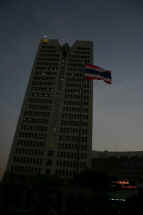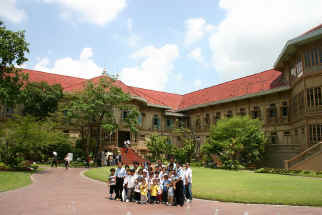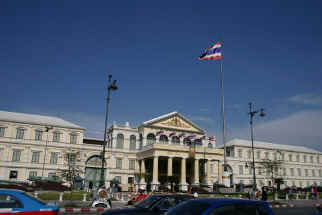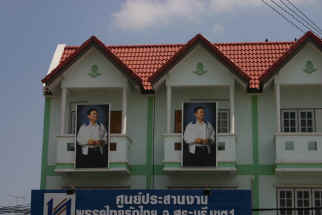|

Politics
in Thailand

For most of it's
history, Thailand had been ruled by absolute monarchs but that changed in 1932
when a revolution changed the ruling power to a constitutional monarchy.
Even with this change, the majority of the power was with the military until
recently.
In 1997, a new
constitution was put into effect, the country's sixteenth, that was formulated
with public opinion as well as incorporating a bill of rights guaranteeing that
all citizens are equal.
The Thai head of
state and armed forces commander in chief, although he doesn't have much direct
power, is the king. In spite of this lack of power, he is able to
influence the political leaders in Thailand. The chief executive official
is the prime minister, who heads the cabinet.
Since the 1997
constitutional change, there have been legislative changes as well.
Senators are now to be directly elected to their four-year terms, whereas before
the new constitution the military appointed them. Representatives are
directly elected also for their four-year terms in the National Assembly.
The National Assembly has the legislative power in Thailand and is comprised of
the House of Representatives (with 500 members) and the Senate (with 245
members).

Change
in 1932
The politics of Thailand took a very significant turn on
24 June 1932 when a group of young intellectuals, educated abroad and imbued
with the concept of Western democracy, staged a bloodless coup demanding a
change from absolute to constitutional monarchy. Determined to avoid any
bloodshed, King Prajadhipok (Rama Vll) agreed to the abolition of absolute
monarchy and the transfer of power to the constitution-based system of
government as demanded.
On
10 December 1932, King Prajadhipok signed Thailand's first constitution and thus
ended 800 years of Thailand's absolute monarchy. Despite the number of
successive constitutions that followed in the span of just over half a century,
the basic concepts of constitution have remained unaltered.

Major
Ingredients in Thai Politics
The first and foremost concept is the status of the
monarch as head of the armed forces and upholder of Buddhism and all other
religions. Every constitution provides that the monarch's person is sacred and
inviolable. His sovereign power emanates from the people, and as head of state,
he exercises his legislative power through parliament, executive power through
the cabinet headed by a prime minister, and judicial power through the courts.
The monarch is empowered with the right to be consulted, the right to encourage,
and the right to warn whenever the government appears not to administer the
state affairs according to his wishes and for the good of the people.
The
second concept concerns the legislative branch. The new leaders of 1932 realized
that the goal of popularly elected government could not be attained immediately,
and that considerable experimentation and adaptation would be necessary before a
balance could be struck. For this reason, the first constitution was a cautious
document that created a bicameral National Assembly with two categories of
members, the House of Representatives (the Lower House) which were elected by
the popular vote, and the Senate (the Upper House) which were appointed by the
King on the recommendation of the Council of Ministers (now called the cabinet).
The number of members in the House of Representatives is determined by the size
of the population, while the number of senators is normally restricted to no
more than three-quarters of the total number of the representatives. This
concept remains a basic principle of successive constitutions in Thai politics.
The
third concept concerns the executive branch. Every constitution holds that the
Prime Minister is head of government and chief executive. A slight difference
between the Thai Prime Minister and those in other countries is that, since the
creation of the post of Prime Minister in 1933. the Thais have often looked upon
their Prime Minister as a protective figure, possibly due to their tendency to
extend family structure into the sphere of government.
For
the past six decades, Thailand has been adopting the Western democratic system
to the needs of a nation with its own identity and time-honored culture. The
constitution was amended in June 1992, making it mandatory that the prime
minister be an elected member of parliament.

The
Government
The cabinet is responsible for the administration of
thirteen ministries and the Office of the Prime Minister. Each ministry is
headed by a politically appointed minister with one or more deputy ministers.
The Prime Minister is assisted by Deputy Prime Ministers as well as a number of
ministers holding the portfolio of "Minister to the Prime Minister's
Office."
Smaller
cabinet committees are set up to help screen proposals from the various
ministries sent to the larger cabinet. This process enables the government to
ensure that no policy is made that is incompatible with other related ones. The
committees may be assigned by the Prime Minister to thoroughly examine the
merits of each project or policy for the cabinet so that the latter will not
have to go into such details before deciding on proposals and spare itself time
to consider other matters.
The
Office of the Prime Minister is a central body, which in itself ranks as a
ministry, whose responsibility is largely concerned with formulating national
policy. Some of its primary subdivisions are the Budget Bureau; the National
Security Council; the Juridical Council; the National Economic and Social
Development Board; the Board of Investment; the Civil Service Commission and
several other organizations vital to the formulation of national policy.
The
fourteen ministries are divided on functional basis. At a time when the economic
growth of the country is one of the highest in the region and the country is in
the process of diversifying from agriculture to industry, the Ministry of
Agriculture and Cooperatives, the Ministry of Industry, the Ministry of Commerce
and the Ministry of Finance play important roles in the Thai Government
The
Ministry of Defense, the Ministry of Interior, and the Ministry of Justice are
in charge of maintaining peace and security and regulating law and order of the
country.
The
Ministry of Education, the Ministry of University Affairs, the Ministry of
Public Health, the Ministry of Labor and Social Welfare and the Ministry of
Transport and Communications are concerned with laying down the ground works of
social and physical infrastructure and welfare for Thai society.
The
Ministry of Science, Technology and Energy effectively keeps pace with
accelerating developments in the country through modern technology, while the
Ministry of Foreign Affairs undertakes to strengthen friendly relations between
Thailand and the outside world.
The
head of career civil servants in each ministry is the permanent secretary, who
has administrative control over all the departments of the ministry, each of
which is headed by a director-general, also a career civil servant.
The
Armed Forces
The Thai Armed Forces are divided into three branches: the
Royal Thai Army (RTA), the Royal Thai Navy (RTN) and the Royal Thai Air Force (RTAF).
Thai soldiers are composed of professional career soldiers and conscripts. Every
male aged between twenty-one and twenty-five is subject to two years of military
service.
The
King is Commander-in-Chief of the Royal Thai Armed Forces and the cabinet is the
instrument through which national security policy is formulated. The Defense
Ministry co-ordinates the administration of the Armed Forces.
Thailand's
fighting forces are governed by the Supreme Command Headquarters which is
staffed by leaders of the Army, Navy and Air Force. Organized into divisions and
combat regiments, the Royal Thai Army is divided into four army regions,
covering Bangkok and the central Plains, the Northeast, the North and the South.
Thailand's
naval fleet, though small, has always given a good account of itself. It perates
primarily out of the sprawling, modern naval station at Sattahip, southeast of
Bangkok. The Royal Navy has a marine corps, modelled on the American pattern,
skilled in both amphibious and jungle operations.
The
Royal Thai Air Force has its main base at Don Muang airport, adjacent to
Bangkok's International Airport. The RTAF also has large air fields and
facilities in the North and Northeast.

Recent
Political Developments
General elections were held in Thailand on 17 November
1996 to elect 393 Members of Parliament. Altogether, as many as 13 different
political parties participated in the elections They fielded a total of 2,310
candidates to compete for the 393 seats that were at stake, with each MP
representing approximately 150,000 people. All Thai citizens over 18 years of
age were eligible to cast their vote. Voter turn-out was 62.42 percent.
The
outcome of the nation-wide elections saw the New Aspiration Party, headed by
General Chavalit Yongchaiyudh, emerge as the largest political party, winning a
total of 125 seats. As a result, Gen. Chavalit was appointed Thailand's 22nd
Prime Minister by Royal Command of H.M. the King, on 25 November 1996.
Prime
Minister Chavalit has formed a six-party coalition government composed of the
New Aspiration Party (125 seats), the Chart Pattana Party (52 seats), the Social
Action Party (20 seats), the Prachakorn Thai Party (18 seats), the Seritham
Party (4 seats) and the Muanchon Party (2 seats). Together, the coalition
commands a strong majority in Parliament, occupying a total of 221 seats. The
new Cabinet was announced on 29 November 1996.
The
November 1996 elections marked the second time in succession that there has been
a peaceful transition of power from one democratically elected government to
another. This demonstrates that democratic principles in Thailand have grown
stronger and are becoming institutionalized.
After
a decision taken by General Chavalit earlier to step down, Prime Minister
Chuan Leekpai as leader of the party with the second most seats in the lower
house was appointed for the second time as Prime Minister of Thailand on
November 9th 1997. On November 14 with the support of five parties and
dissident members of a six party PM Chuan formed a coalition government
with a small majority in the lower House of Representatives.
On
October 5th, 1998, Chat Pattana Party with 52 seats joined the government
coalition and with Members of Parliament retiring, dying or joining other
parties the Chuan Leekpai Administration presently holds 254 MP votes in the
Thai Parliament. The Opposition with the leadership of New Aspiration Party's
leader Gen. Chavalit Yongchaiyuth holds 129 MPs with 5 from the Thai Citizen
Party. In addition, The Palang Dharma and Thai Party each have
one MP in the parliament, they both claim to be independent voting
according to their beliefs.
more...
Back to Top...
|
Country
name:
|
|
conventional
long form: Kingdom
of Thailand
conventional
short form: Thailand
local
long form: Ratcha
Anachak Thai
local
short form: Prathet
Thai
former:
Siam
|
|
|
Government
type:
|
|
constitutional
monarchy
|
|
|
Capital:
|
|
name: Bangkok
geographic
coordinates: 13
45 N, 100 31 E
time
difference: UTC+7
(12 hours ahead of Washington, DC during Standard
Time)
|
|
|
Administrative
divisions:
|
|
76
provinces (changwat, singular and plural); Amnat
Charoen, Ang Thong, Buriram, Chachoengsao, Chai
Nat, Chaiyaphum, Chanthaburi, Chiang Mai, Chiang
Rai, Chon Buri, Chumphon, Kalasin, Kamphaeng Phet,
Kanchanaburi, Khon Kaen, Krabi, Krung Thep
Mahanakhon (Bangkok), Lampang, Lamphun, Loei, Lop
Buri, Mae Hong Son, Maha Sarakham, Mukdahan,
Nakhon Nayok, Nakhon Pathom, Nakhon Phanom, Nakhon
Ratchasima, Nakhon Sawan, Nakhon Si Thammarat,
Nan, Narathiwat, Nong Bua Lamphu, Nong Khai,
Nonthaburi, Pathum Thani, Pattani, Phangnga,
Phatthalung, Phayao, Phetchabun, Phetchaburi,
Phichit, Phitsanulok, Phra Nakhon Si Ayutthaya,
Phrae, Phuket, Prachin Buri, Prachuap Khiri Khan,
Ranong, Ratchaburi, Rayong, Roi Et, Sa Kaeo, Sakon
Nakhon, Samut Prakan, Samut Sakhon, Samut
Songkhram, Sara Buri, Satun, Sing Buri, Sisaket,
Songkhla, Sukhothai, Suphan Buri, Surat Thani,
Surin, Tak, Trang, Trat, Ubon Ratchathani, Udon
Thani, Uthai Thani, Uttaradit, Yala, Yasothon
|
|
|
Independence:
|
|
1238
(traditional founding date; never colonized)
|
|
|
National
holiday:
|
|
Birthday
of King PHUMIPHON (BHUMIBOL), 5 December (1927)
|
|
|
Constitution:
|
|
24
August 2007
|
|
|
Legal
system:
|
|
based
on civil law system with influences of common law;
has not accepted compulsory ICJ jurisdiction
|
|
|
Suffrage:
|
|
18
years of age; universal and compulsory
|
|
|
Executive
branch:
|
|
chief
of state: King
PHUMIPHON Adunyadet, also spelled BHUMIBOL
Adulyadej (since 9 June 1946)
head
of government: Prime
Minister ABHISIT Wetchachiwa, also spelled ABHISIT
Vejjajiva (since 17 December 2008); Deputy Prime
Minister SANAN Kachornprasat, also spelled SANAN
Kachornparsart (since 7 February 2008); Deputy
Prime Minister SUTHEP Thueaksuban, also spelled
SUTHEP Thaugsuban (since 22 December 2008); Deputy
Prime Minister TRAIRONG Suwannakhiri (since 18
January 2010)
cabinet:
Council
of Ministers
(For
more information visit the World Leaders website  ) )
note:
there
is also a Privy Council advising the king
elections:
the
monarchy is hereditary; according to 2007
constitution, the prime minister elected from
among members of House of Representatives;
following national elections for House of
Representatives, the leader of the party
positioned to organize a majority coalition
usually becomes prime minister by appointment by
the king; the prime minister limited to two
four-year terms
|
|
|
Legislative
branch:
|
|
bicameral
National Assembly or Rathasapha consisted of the
Senate or Wuthisapha (150 seats; 76 members
elected by popular vote representing 76 provinces,
74 appointed by judges and independent government
bodies; members serve six-year terms) and the
House of Representatives or Sapha Phuthaen
Ratsadon (480 seats; 400 members elected from 157
multi-seat constituencies and 80 elected on
proportional party-list basis of 10 per eight
zones or groupings of provinces; members serve
four-year terms)
elections:
Senate
- last held on 2 March 2008 (next to be held in
March 2014); House of Representatives - last
election held on 23 December 2007 (next to be held
by December 2011)
election
results: Senate
- percent of vote by party - NA; seats by party -
NA; House of Representatives - percent of vote by
party - NA; seats by party - PPP 233, DP 164, TNP
34, Motherland 24, Middle Way 11, Unity 9,
Royalist People's 5; following the PPP's
dissolution in December 2008, most of the party's
seats were assumed by its successor, the Phuea
Thai Party
note:
74
senators were appointed on 19 February 2008 by a
seven-member committee headed by the chief of the
Constitutional Court; 76 senators were elected on
2 March 2008; elections to the Senate are
non-partisan; registered political party members
are disqualified from being senators
|
|
|
Judicial
branch:
|
|
Constitutional
Court, Supreme Court of Justice, and Supreme
Administrative Court; all judges are appointed by
the king; the king's appointments to the
Constitutional Courtare made upon the advice of
the Senate; the nine Constitutional Court judges
are drawn from the Supreme Court of Justice and
Supreme Administrative Court as well as from among
substantive experts in law and social sciences
outside the judiciary
|
|
|
Political
parties and leaders:
|
|
Chat
Thai Phattana Party or CP (Thai Nation Development
Party) [CHUMPON Silpa-archa]; Democrat Party or DP
(Prachathipat Party) [ABHISIT Wetchachiwa, also
spelled ABHISIT Vejjajiva]; Motherland Party (Phuea
Phaendin Party) [CHANCHAI Chairungrueng]; Phuea
Thai Party (For Thais Party) or PTP [YONGYUTH
Wichaidit]; Phumjai (Bhumjai) Thai Party or PJT
(Thai Pride) [CHAWARAT Chanvirakun]; Royalist
People's Party (Pracharaj) [SANOH Thienthong];
Ruam Jai Thai Party (Thai Unity Party) [WANNARAT
Channukun]
|
|
|
Political
pressure groups and leaders:
|
|
People's
Alliance for Democracy or PAD; United Front for
Democracy Against Dictatorship or UDD
|
|
|
International
organization participation:
|
|
ADB,
APEC, ARF, ASEAN, BIMSTEC, BIS, CICA, CP, EAS, FAO,
G-77, IAEA, IBRD, ICAO, ICC, ICRM, IDA, IFAD, IFC,
IFRCS, IHO, ILO, IMF, IMO, IMSO, Interpol, IOC,
IOM, IPU, ISO, ITSO, ITU, ITUC, MIGA, NAM, OAS
(observer), OIC (observer), OIF (observer), OPCW,
OSCE (partner), PCA, PIF (partner), UN, UNAMID,
UNCTAD, UNESCO, UNHCR, UNIDO, UNMIS, UNWTO, UPU,
WCO, WFTU, WHO, WIPO, WMO, WTO
|
|
|
Diplomatic
representation in the US:
|
|
chief
of mission: Ambassador
Kittiphong Na RANONG
chancery:
1024
Wisconsin Avenue NW, Suite 401, Washington, DC
20007
telephone:
[1]
(202) 944-3600
FAX: [1]
(202) 944-3611
consulate(s)
general: Chicago,
Los Angeles, New York
|
|
|
Diplomatic
representation from the US:
|
|
chief
of mission: Ambassador
Kristie A. KENNEY
embassy:
120-122
Wireless Road, Bangkok 10330
mailing
address: APO
AP 96546
telephone:
[66]
(2) 205-4000
FAX: [66]
(2) 254-2990, 205-4131
consulate(s)
general: Chiang
Mai
|
|
|
Flag
description:
|
|
five
horizontal bands of red (top), white, blue (double
width), white, and red; the red color symbolizes
the nation and the blood of life; white represents
religion and the purity of Buddhism; blue stands
for the monarchy
note:
similar
to the flag of Costa Rica but with the blue and
red colors reversed
|
|
|
National
anthem:
|
|
name: "Phleng
Chat Thai" (National Anthem of Thailand)
lyrics/music:
LUANG
Saranuprapan/PHRA Jenduriyang
note:
music
adopted 1932, lyrics adopted 1939; by law, people
are required to stand for the national anthem at
0800 and 1800 every day; the anthem is played in
schools, offices, theaters, and on television and
radio during this time; "Phleng Sansasoen
Phra Barami" (A Salute to the Monarch) serves
as the royal anthem and is played in the presence
of the royal family and during certain state
ceremonies
|
|









